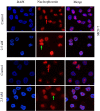Cucurbitacin B inhibits human breast cancer cell proliferation through disruption of microtubule polymerization and nucleophosmin/B23 translocation
- PMID: 23062075
- PMCID: PMC3527297
- DOI: 10.1186/1472-6882-12-185
Cucurbitacin B inhibits human breast cancer cell proliferation through disruption of microtubule polymerization and nucleophosmin/B23 translocation
Abstract
Background: Cucurbitacin B, an oxygenated tetracyclic triterpenoid compound extracted from the Thai medicinal plant Trichosanthes cucumerina L., has been reported to have several biological activities including anti-inflammatory, antimicrobial and anticancer. Cucurbitacin B is great of interest because of its biological activity. This agent inhibits growth of various types of human cancer cells lines.
Methods: In this study, we explored the novel molecular response of cucurbitacin B in human breast cancer cells, MCF-7 and MDA-MB-231. The growth inhibitory effect of cucurbitacin B on breast cancer cells was assessed by MTT assay. The effects of cucurbitacin B on microtubules morphological structure and tubulin polymerization were analyzed using immunofluorescence technique and tubulin polymerization assay kit, respectively. Proteomic analysis was used to identify the target-specific proteins that involved in cucurbitacin B treatment. Some of the differentially expressed genes and protein products were validated by real-time RT-PCR and western blot analysis. Cell cycle distributions and apoptosis were investigated using flow cytometry.
Results: Cucurbitacin B exhibited strong antiproliferative effects against breast cancer cells in a dose-dependent manner. We show that cucurbitacin B prominently alters the cytoskeletal network of breast cancer cells, inducing rapid morphologic changes and improper polymerization of the microtubule network. Moreover, the results of 2D-PAGE, real-time RT-PCR, and western blot analysis revealed that the expression of nucleophosmin/B23 and c-Myc decreased markedly after cucurbitacin B treatment. Immunofluorescence microscopy showed that cucurbitacin B induced translocation of nucleophosmin/B23 from the nucleolus to nucleoplasm. Treatment with cucurbitacin B resulted in cell cycle arrest at G2/M phase and the enhancement of apoptosis.
Conclusions: Our findings suggest that cucurbitacin B may inhibit the proliferation of human breast cancer cells through disruption of the microtubule network and down-regulation of c-Myc and nucleophosmin/B23 as well as the perturbation in nucleophosmin/B23 trafficking from the nucleolus to nucleoplasm, resulting in G2/M arrest.
Figures








Similar articles
-
Inhibition of Wnt signaling by cucurbitacin B in breast cancer cells: reduction of Wnt-associated proteins and reduced translocation of galectin-3-mediated β-catenin to the nucleus.J Cell Biochem. 2012 Jan;113(1):49-60. doi: 10.1002/jcb.23326. J Cell Biochem. 2012. PMID: 21866566 Free PMC article.
-
Cucurbitacin B Induces Hypermethylation of Oncogenes in Breast Cancer Cells.Planta Med. 2019 Mar;85(5):370-378. doi: 10.1055/a-0791-1591. Epub 2018 Nov 21. Planta Med. 2019. PMID: 30463098
-
Antiproliferative effects of cucurbitacin B in breast cancer cells: down-regulation of the c-Myc/hTERT/telomerase pathway and obstruction of the cell cycle.Int J Mol Sci. 2010;11(12):5323-38. doi: 10.3390/ijms11125323. Epub 2010 Dec 22. Int J Mol Sci. 2010. PMID: 21614210 Free PMC article.
-
Potential of cucurbitacin as an anticancer drug.Biomed Pharmacother. 2023 Dec;168:115707. doi: 10.1016/j.biopha.2023.115707. Epub 2023 Oct 18. Biomed Pharmacother. 2023. PMID: 37862969 Review.
-
Cucurbitacin B and Its Derivatives: A Review of Progress in Biological Activities.Molecules. 2024 Sep 4;29(17):4193. doi: 10.3390/molecules29174193. Molecules. 2024. PMID: 39275042 Free PMC article. Review.
Cited by
-
Modulation of Cytoskeleton, Protein Trafficking, and Signaling Pathways by Metabolites from Cucurbitaceae, Ericaceae, and Rosaceae Plant Families.Pharmaceuticals (Basel). 2022 Nov 10;15(11):1380. doi: 10.3390/ph15111380. Pharmaceuticals (Basel). 2022. PMID: 36355554 Free PMC article. Review.
-
Anticancer mechanism of 7-α-hydroxyfrullanolide on microtubules and computational prediction of its target binding in triple-negative breast cancer cells.PeerJ. 2022 May 27;10:e13508. doi: 10.7717/peerj.13508. eCollection 2022. PeerJ. 2022. PMID: 35651747 Free PMC article.
-
Functional Characterisation of Anticancer Activity in the Aqueous Extract of Helicteres angustifolia L. Roots.PLoS One. 2016 Mar 24;11(3):e0152017. doi: 10.1371/journal.pone.0152017. eCollection 2016. PLoS One. 2016. PMID: 27010955 Free PMC article.
-
K092A and K092B, Two Peptides Isolated from the Dogfish (Scyliorhinus canicula L.), with Potential Antineoplastic Activity Against Human Prostate and Breast Cancer Cells.Mar Drugs. 2019 Nov 28;17(12):672. doi: 10.3390/md17120672. Mar Drugs. 2019. PMID: 31795172 Free PMC article.
-
Nucleolar Stress: hallmarks, sensing mechanism and diseases.Cell Stress. 2018 May 10;2(6):125-140. doi: 10.15698/cst2018.06.139. Cell Stress. 2018. PMID: 31225478 Free PMC article. Review.
References
-
- Desantis C, Siegel R, Bandi P, Jemal A. Breast cancer statistics, 2011. CA Cancer J Clin. 2011;61:409–418. - PubMed
-
- Mavrogenis AF, Pala E, Romantini M, Guerra G, Romagnoli C, Maccauro G, Ruggieri P. Side effects of radiation in musculoskeletal oncology: clinical evaluation of radiation-induced fractures. Int J Immunopathol Pharmacol. 2011;24:29–37. - PubMed
Publication types
MeSH terms
Substances
Grants and funding
LinkOut - more resources
Full Text Sources
Medical
Miscellaneous

